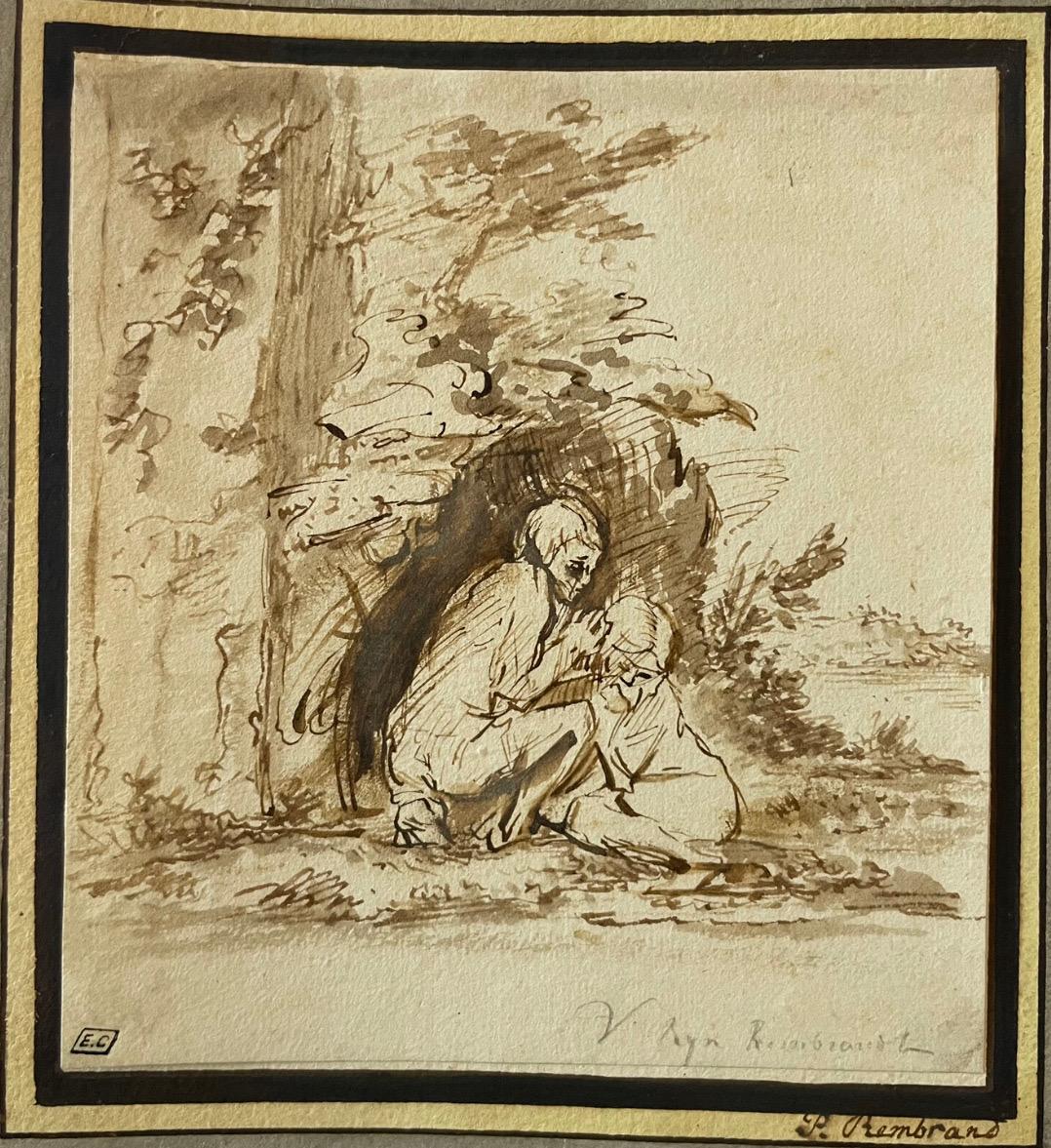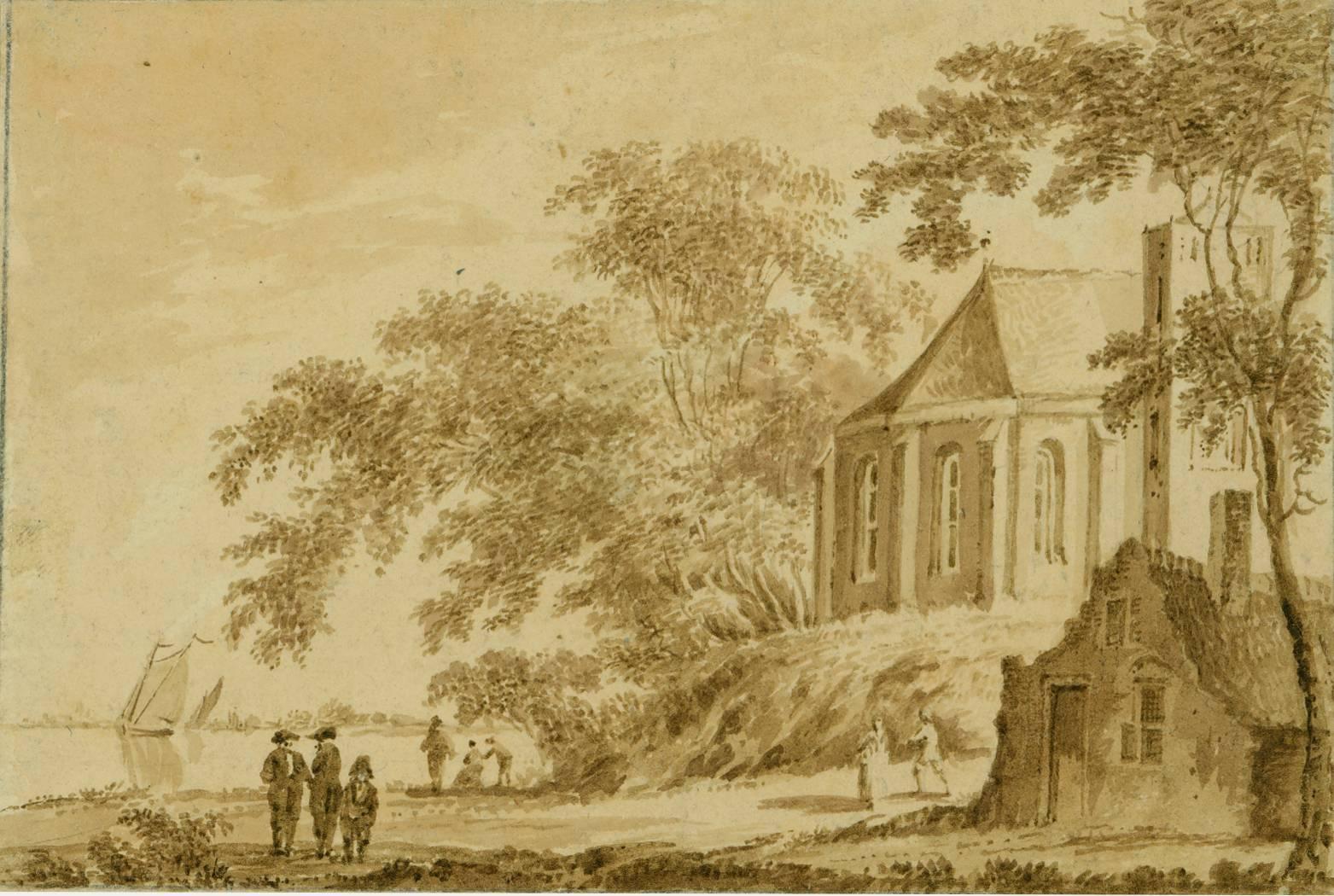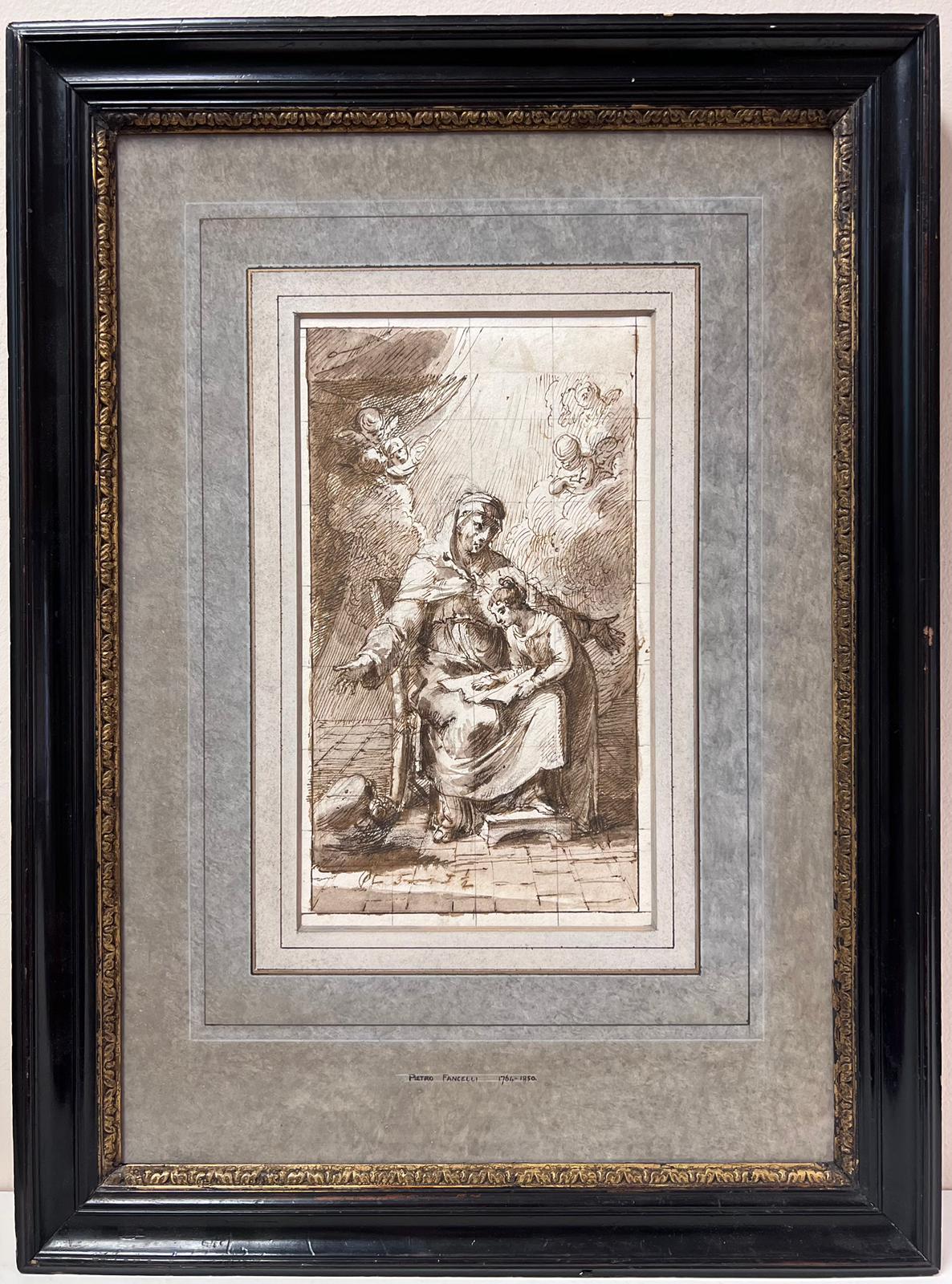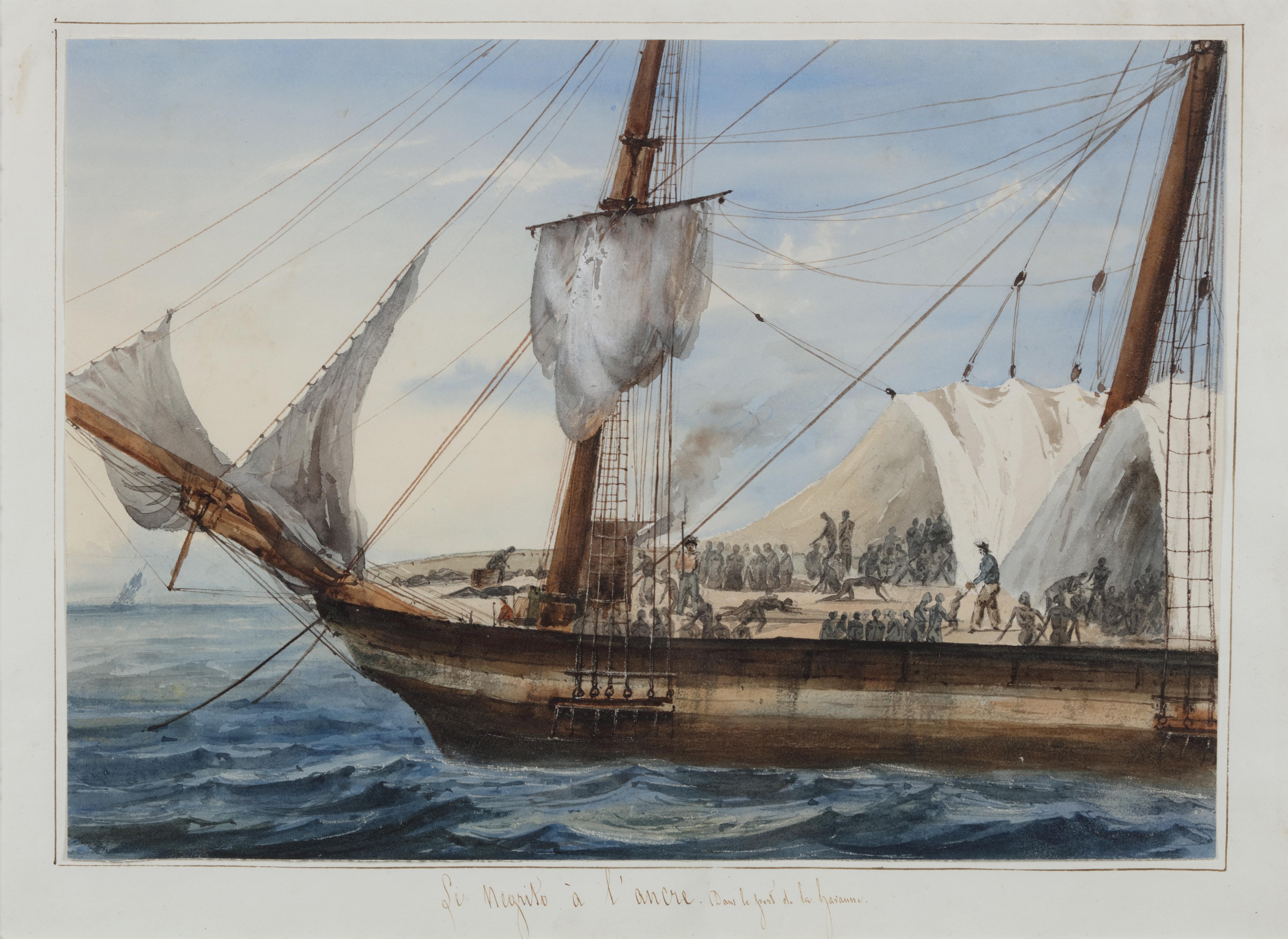Items Similar to Man Eating Spaghetti - Watercolor by M. De Vito - 1820 ca.
Want more images or videos?
Request additional images or videos from the seller
1 of 2
Michela De VitoMan Eating Spaghetti - Watercolor by M. De Vito - 1820 ca.1820 c.a.
1820 c.a.
About the Item
Man Eating Spaghetti is an original watercolor on ivory-colored paper, realized by the old master Michela De Vito in 1828.
The year is written by the author, Michela De Vito, in pencil on the lower right margin. Excellent conditions except for some light stains.
This amusing artworks represents a standing man of the lower class eating some spaghetti with his hands.
Remarkable is the artist's sophisticated technique in depicting the subject. This watercolor is of good quality for both the drawing itself and for the fineness of the colors the artist used.
Michela De Vito
In the XIX century, Michela De Vito native of Abruzzi, worked in Naples and became a famous artist. She was maybe the daughter or sister of Camillo de Vito, a reknown painter of guaches above all of views and scenes of everyday life. Sometimes she is mistaken with Michele de Vito. “A refined painter, very skilled when it came to drawings, she had the characteristic to make her subject more gentle, compared to her male collegues"; this is how De Rosa and Trastulli describe her.
This artwork is shipped from Italy. Under existing legislation, any artwork in Italy created over 70 years ago by an artist who has died requires a licence for export regardless of the work’s market price. The shipping may require additional handling days to require the licence according to the final destination of the artwork.
- Creator:Michela De Vito (1800, Italian)
- Creation Year:1820 c.a.
- Dimensions:Height: 10.44 in (26.5 cm)Width: 8.08 in (20.5 cm)Depth: 0.04 in (1 mm)
- Medium:
- Movement & Style:
- Period:
- Framing:Framing Options Available
- Condition:Insurance may be requested by customers as additional service, contact us for more information.
- Gallery Location:Roma, IT
- Reference Number:
About the Seller
4.9
Platinum Seller
These expertly vetted sellers are 1stDibs' most experienced sellers and are rated highest by our customers.
1stDibs seller since 2017
6,693 sales on 1stDibs
Typical response time: 2 hours
- ShippingRetrieving quote...Ships From: Rome, Italy
- Return PolicyA return for this item may be initiated within 14 days of delivery.
More From This SellerView All
- Female Nudes - Charcoal, Ink and Watercolor DrawingLocated in Roma, ITFemale Nudes is a fine original drawing (China ink and watercolor on paper). Unsigned. This artwork could be attributed to Thomas Stothard. Although th...Category
Mid-19th Century Old Masters Figurative Drawings and Watercolors
MaterialsCharcoal, Ink, Watercolor
- Martyrdom of Saint Bartholomew - Drawing - 17th CenturyLocated in Roma, ITMartyrdom of Saint Bartholomew is a precious original drawing (black and red chalk, pen and China ink on laid paper, laid down on canvas) realized by...Category
17th Century Old Masters Figurative Drawings and Watercolors
MaterialsCharcoal, Ink, Watercolor
- In a Gothic ChurchLocated in Roma, ITIn a Gothic Church is a beautiful original drawing (China ink and watercolor on paper). Hand-signed "Stothard" in brown ink on the lower left margin outside of the image. Very sweet drawing representing a woman praying...Category
19th Century Old Masters Figurative Drawings and Watercolors
MaterialsCharcoal, Ink, Watercolor
- Brigante - Watercolor 1820 ca.By Michela De VitoLocated in Roma, ITWatercolour on ivory colored paper, 1820 c.a.. Hand titled and signed. Representing brigand. Very good conditions. Very beautiful and good quality watercolour both for the drawing a...Category
1820s Old Masters Figurative Drawings and Watercolors
MaterialsWatercolor
- Opera dei PupiBy Michela De VitoLocated in Roma, ITWatercolour on ivory colored paper stuck onwhite cardboard sheet, 1820 c.a. Representing people attending the typical Sicilian"Operadei Pupi". Excellent conditionsexcept a little sta...Category
1820s Old Masters Figurative Drawings and Watercolors
MaterialsWatercolor
- Woman in Typical Costumes - Watercolor by M. De Vito - 1820 ca.By Michela De VitoLocated in Roma, ITWatercolour on ivory colored paper, 1828. Representing a woman in typical Italian costumes of XIX century. Good conditions with some light stains. The year of composition is hand-wri...Category
1820s Old Masters Figurative Drawings and Watercolors
MaterialsWatercolor
You May Also Like
- French school circa 1840, Portrait of a Lady, watercolorLocated in Paris, FRFrench school circa 1840 Portrait of a Lady watercolor on Bristol paper 25.5 x 20 cm oval in quite good condition : slightly yellowed by time, multiple little scratches, stains (see ...Category
1840s Old Masters Portrait Drawings and Watercolors
MaterialsWatercolor
- 17th C Dutch Old Master Ink & Wash Painting Biblical Figures Rembrandt PupilLocated in Cirencester, GloucestershireFigure being Comforted (Job?) circle of Willem Drost (Dutch 1633-1659) *See notes below ink and wash drawing on paper (Arms of Amsterdam watermarked) Dutc...Category
Mid-17th Century Old Masters Figurative Drawings and Watercolors
MaterialsInk, Watercolor
- View of the KagermeerBy Hendrick V. TavernierLocated in Storrs, CTInk and watercolor on paper. 3 1/2 x 5 1/4. Unsigned. Excellent condition on cream laid paper, tipped onto a backing sheet at the top corners. Annotated "Tavernier" verso, and "Hendr...Category
Late 19th Century Old Masters Landscape Drawings and Watercolors
MaterialsInk, Watercolor
- Italian Old Master Ink & Wash Drawing St. Anne & The Virgin Mary with CherubsLocated in Cirencester, GloucestershirePietro Fancelli (Italian 1764 - 1850) bio details attached to the frame 'St. Anne & The Virgin' ink with watercolor wash on paper, framed framed: 22 x 16 inches image: 11 x 6.5 inche...Category
Late 18th Century Old Masters Figurative Drawings and Watercolors
MaterialsInk, Watercolor
- Portrait of a Slave Ship: 'Le Negrito à l’ancre. Dans le port de la havanne'Located in Amsterdam, NLFRANÇOIS MATHURIN ADALBERT, BARON DE COURCY (1805-1839) 'Le Negrito à l’ancre. Dans le port de la havanne' Indistinctly signed lower left Titled on the mount Pencil and watercolour, heightened with white, on paper, 24.8 x 34.6 cm Literature: The present watercolour will be illustrated in: - Prof. Manuel Garcia’s projected book on the disease and the slave trade provisionally titled “Fighting the Yellow Demon of Fever: The Struggle against Disease in the Illegal Slave Trade”. - Prof. Micael Zeuske’s forthcoming Global history of slave trade. Exhibited: Mexico City, 1998, Palacio Virreinal, El Barón de Courcy, illustrationes de un viaje, 1831-1833, no. 108 Note: Baron de Courcy was in the Caribbean in late 1832 and early 1833, following his tour of Mexico in 1832, on the last leg of his “Grand Voyage...Category
Mid-19th Century Old Masters Figurative Drawings and Watercolors
MaterialsGouache, Pencil, Paper, Watercolor
- The Abduction of the Sabine Women , a Renaissance drawing by Biagio PupiniLocated in PARIS, FRThis vigorous drawing has long been attributed to Polidoro da Caravaggio: The Abduction of the Sabine Women is one of the scenes that Polidoro depicted between 1525 and 1527 on the façade of the Milesi Palazzo in Rome. However, the proximity to another drawing inspired by this same façade, kept at the Ecole des Beaux-Arts, and to other drawings inspired by Polidoro kept at the Musée du Louvre, leads us to propose an attribution to Biagio Pupini, a Bolognese artist whose life remains barely known, despite the abundant number of drawings attributed to him. 1. Biagio Pupini, a Bolognese artist in the light of the Roman Renaissance The early life of Biagio Pupini, an important figure of the first half of the Cinquecento in Bologna - Vasari mentions him several times - is still poorly known. Neither his date of birth (probably around 1490-1495) nor his training are known. He is said to have been a pupil of Francesco Francia (1450 - 1517) and his name appears for the first time in 1511 in a contract with the painter Bagnacavallo (c. 1484 - 1542) for the frescoes of a church in Faenza. He then collaborated with Girolamo da Carpi, at San Michele in Bosco and at the villa of Belriguardo. He must have gone to Rome for the first time with Bagnacavallo between 1511 and 1519. There he discovered the art of Raphael, with whom he might have worked, and that of Polidoro da Caravaggio. This first visit, and those that followed, were the occasion for an intense study of ancient and modern art, as illustrated by his abundant graphic production. Polidoro da Caravaggio had a particular influence on the technique adopted by Pupini. Executed on coloured paper, his drawings generally combine pen, brown ink and wash with abundant highlights of white gouache, as in the drawing presented here. 2. The Abduction of the Sabine Women Our drawing is an adaptation of a fresco painted between 1525 and 1527 by Polidoro da Caravaggio on the façade of the Milesi Palace in Rome. These painted façades were very famous from the moment they were painted and inspired many artists during their stay in Rome. These frescoes are now very deteriorated and difficult to see, as the palace is in a rather narrow street. The episode of the abduction of the Sabine women (which appears in the centre of the photo above) is a historical theme that goes back to the origins of Rome and is recounted both by Titus Livius (Ab Urbe condita I,13), by Ovid (Fasti III, 199-228) and by Plutarch (II, Romulus 14-19). After killing his twin brother Romus, Romulus populates the city of Rome by opening it up to refugees and brigands and finds himself with an excess of men. Because of their reputation, none of the inhabitants of the neighbouring cities want to give them their daughters in marriage. The Romans then decide to invite their Sabine neighbours to a great feast during which they slaughter the Sabines and kidnap their daughters. The engraving made by Giovanni Battista Gallestruzzi (1618 - 1677) around 1656-1658 gives us a good understanding of the Polidoro fresco, allowing us to see how Biagio Pupini reworked the scene to extract this dynamic group. With a remarkable economy of means, Biagio Pupini takes over the left-hand side of the fresco and depicts in a very dense space two main groups, each consisting of a Roman and a Sabine, completed by a group of three soldiers in the background (which seems to differ quite significantly from Polidoro's composition). The balance of the drawing is based on a very strongly structured composition. The drawing is organised around a median vertical axis, which runs along both the elbow of the kidnapped Sabine on the left and the foot of her captor, and the two main diagonals, reinforced by four secondary diagonals. This diamond-shaped structure creates an extremely dynamic space, in which centripetal movements (the legs of the Sabine on the right, the arm of the soldier on the back at the top right) and centrifugal movements (the arm of the kidnapper on the left and the legs of the Sabine he is carrying away, the arm of the Sabine on the right) oppose each other, giving the drawing the appearance of a whirlpool around a central point of support situated slightly to the left of the navel of the kidnapper on the right. 3. Polidoro da Caravaggio, and the decorations of Roman palaces Polidoro da Caravaggio was a paradoxical artist who entered Raphael's (1483 - 1520) workshop at a very young age, when he oversaw the Lodges in the Vatican. Most of his Roman work, which was the peak of his career, has disappeared, as he specialised in facade painting, and yet these paintings, which are eminently visible in urban spaces, have influenced generations of artists who copied them abundantly during their visits to Rome. Polidoro Caldara was born in Caravaggio around 1495-1500 (the birthplace of Michelangelo Merisi, known as Caravaggio, who was born there in 1571), some forty kilometres east of Milan. According to Vasari, he arrived as a mason on the Vatican's construction site and joined Raphael's workshop around 1517 (at the age of eighteen according to Vasari). This integration would have allowed Polidoro to work not only on the frescoes of the Lodges, but also on some of the frescoes of the Chambers, as well as on the flat of Cardinal Bibiena in the Vatican. After Raphael's death in 1520, Polidoro worked first with Perin del Vaga before joining forces with Maturino of Florence (1490 - 1528), whom he had also known in Raphael's workshop. Together they specialised in the painting of palace façades. They were to produce some forty façades decorated with grisaille paintings imitating antique bas-reliefs. The Sack of Rome in 1527, during which his friend Maturino was killed, led Polidoro to flee first to Naples (where he had already stayed in 1523), then to Messina. It was while he was preparing his return to the peninsula that he was murdered by one of his assistants, Tonno Calabrese, in 1543. In his Vite, Vasari celebrated Polidoro as the greatest façade decorator of his time, noting that "there is no flat, palace, garden or villa in Rome that does not contain a work by Polidoro". Polidoro's facade decorations, most of which have disappeared as they were displayed in the open air, constitute the most important lost chapter of Roman art of the Cinquecento. The few surviving drawings of the painter can, however, give an idea of the original appearance of his murals and show that he was an artist of remarkable and highly original genius. 4. The façade of the Milesi Palace Giovanni Antonio Milesi, who commissioned this palace, located not far from the Tiber, north of Piazza Navona, was a native of the Bergamo area, like Polidoro, with whom he maintained close friendly ties. Executed in the last years before the Sack of Rome, around 1526-1527, the decoration of Palazzo Milesi is considered Polidoro's greatest decorative success. An engraving by Ernesto Maccari made at the end of the nineteenth century allows us to understand the general balance of this façade, which was still well preserved at the time. The frescoes were not entirely monochrome, but alternated elements in chiaroscuro simulating marble bas-reliefs and those in ochre simulating bronze and gold vases...Category
16th Century Old Masters Figurative Drawings and Watercolors
MaterialsInk, Gouache, Pen





